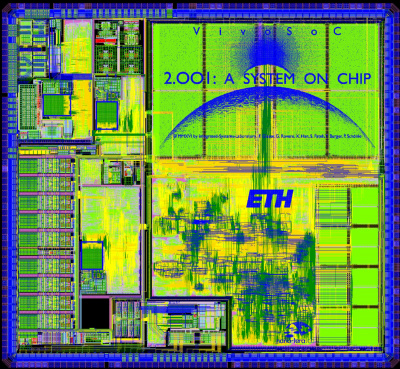Difference between revisions of "Biomedical System on Chips"
From iis-projects
| Line 1: | Line 1: | ||
[[File:Vivosoc2001_eda.jpg|400px|thumb|right]] | [[File:Vivosoc2001_eda.jpg|400px|thumb|right]] | ||
| − | + | Every human and animal body generates a steady and large amount of data as consequence of several ongoing life-long processes, e.g., respiration, vascular system, muscle contraction. | |
| − | + | By acquiring and processing these vital signals, usually by electrical or optical means, large amount of information can be extracted enabling sense-making being used to take informative decisions. Successful application examples range from commercial fitness-tracker gadgets to medical-grade devices that enables tele-health remote medicine, as well as edge-cutting scientific research on living biological models. | |
| + | Even though part of larger Internet-of-Things vision, the point-of-contact that interfaces the biological system with the cloud-based digital world is very critical due to unique specifications and tight trade-offs. | ||
| + | Together with the Analog and Mixed Signal Design Group we are exploring deep integration of analog precision circuits with the digital processor of the PULP family, both workforce and expertise culminated with the VivoSoC project. | ||
| + | Over the years, several prototypes have been developed toward higher integration and better energy efficiency. | ||
| − | |||
This is an ongoing project at our lab and we are looking for motivated students to contribute on the following topics: | This is an ongoing project at our lab and we are looking for motivated students to contribute on the following topics: | ||
| − | + | - Analog circuit design and layout for low-power high-precision biomedical applications. | |
| − | + | - Digital design of efficient processing units, filters, processors. | |
| − | + | - Software/firmware development to show the existing hardware potentiality in real applications (Digital Signal Processing, Machine Learning Algorithms). | |
| − | + | - PCB design to enable new applications with tight form factors. | |
| − | + | If you are interested in the VivoSoC project or in any of the above topics just contact one of us. | |
| − | PCB | + | |
| − | If you are interested in any of the above topics | + | |
Revision as of 19:31, 22 February 2018
Every human and animal body generates a steady and large amount of data as consequence of several ongoing life-long processes, e.g., respiration, vascular system, muscle contraction. By acquiring and processing these vital signals, usually by electrical or optical means, large amount of information can be extracted enabling sense-making being used to take informative decisions. Successful application examples range from commercial fitness-tracker gadgets to medical-grade devices that enables tele-health remote medicine, as well as edge-cutting scientific research on living biological models. Even though part of larger Internet-of-Things vision, the point-of-contact that interfaces the biological system with the cloud-based digital world is very critical due to unique specifications and tight trade-offs. Together with the Analog and Mixed Signal Design Group we are exploring deep integration of analog precision circuits with the digital processor of the PULP family, both workforce and expertise culminated with the VivoSoC project. Over the years, several prototypes have been developed toward higher integration and better energy efficiency.
This is an ongoing project at our lab and we are looking for motivated students to contribute on the following topics: - Analog circuit design and layout for low-power high-precision biomedical applications. - Digital design of efficient processing units, filters, processors. - Software/firmware development to show the existing hardware potentiality in real applications (Digital Signal Processing, Machine Learning Algorithms). - PCB design to enable new applications with tight form factors. If you are interested in the VivoSoC project or in any of the above topics just contact one of us.
Contents
Contact Information
Florian Glaser
- e-mail: glaserf@iis.ee.ethz.ch
- ETZ J71.2
Giovanni Rovere
- e-mail: rovereg@iis.ee.ethz.ch
- ETZ J64.2
Projects
Available Projects
More to follow soon!
Projects In Progress
